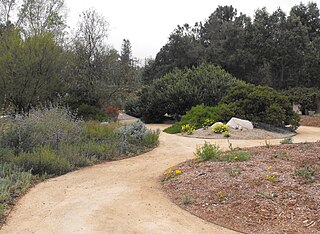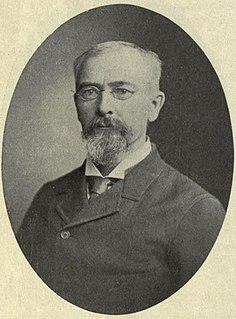
Monocotyledons, commonly referred to as monocots, are grass and grass-like flowering plants (angiosperms), the seeds of which typically contain only one embryonic leaf, or cotyledon. They constitute one of the major groups into which the flowering plants have traditionally been divided, the rest of the flowering plants having two cotyledons and therefore classified as dicotyledons, or dicots.

The California Botanic Garden is a botanical garden in Claremont, California, in the United States, just south of the San Gabriel foothills. The garden, at 86 acres (35 ha), is a non-profit organization dedicated to California native plants. The facility was open to the public with free admission for 58 years; in 2009 an admission fee was implemented.
Botanical nomenclature is the formal, scientific naming of plants. It is related to, but distinct from taxonomy. Plant taxonomy is concerned with grouping and classifying plants; botanical nomenclature then provides names for the results of this process. The starting point for modern botanical nomenclature is Linnaeus' Species Plantarum of 1753. Botanical nomenclature is governed by the International Code of Nomenclature for algae, fungi, and plants (ICN), which replaces the International Code of Botanical Nomenclature (ICBN). Fossil plants are also covered by the code of nomenclature.
A system of plant taxonomy by John Hutchinson, the Hutchinson system, was published as The families of flowering plants, arranged according to a new system based on their probable phylogeny in three editions; 1st edition 1926–1934; 2nd edition 1959; 3rd edition, 1973. This classification is according to the 1st Edition Volume 1: Dicotyledonae 1926 and Volume 2:Monocotyledonae 1934.

Lilianae is a botanical name for a superorder of flowering plants. Such a superorder of necessity includes the type family Liliaceae. Terminations at the rank of superorder are not standardized by the International Code of Nomenclature for algae, fungi, and plants (ICN), although the suffix -anae has been proposed.

James Lauritz Reveal was a U.S. botanist best known for his contributions to the genus Eriogonum and for his work on suprageneric names. His website, at PlantSystematics.org, also presents material on plant taxonomy including the Reveal system. He published extensively on North American flora, was a member of the Angiosperm Phylogeny Group, and was one of the authors of the APG II and APG III classifications.

Elmer Drew Merrill was an American botanist and taxonomist. He spent more than twenty years in the Philippines where he became a recognized authority on the flora of the Asia-Pacific region. Through the course of his career he authored nearly 500 publications, described approximately 3,000 new plant species, and amassed over one million herbarium specimens. In addition to his scientific work he was an accomplished administrator, college dean, university professor and editor of scientific journals.
Philip Alexander Munz, botanist, plant taxonomist and educator (1892–1974), worked at the Rancho Santa Ana Botanic Garden, and was a professor of botany at Pomona College, serving as dean there for three years.
Australian Systematic Botany is an international peer-reviewed scientific journal published by CSIRO Publishing. It is devoted to publishing original research, and sometimes review articles, on topics related to systematic botany, such as biogeography, taxonomy and evolution. The journal is broad in scope, covering all plant, algal and fungal groups, including fossils.

Cantua is a genus of flowering plants in the family Polemoniaceae which is in the order Ericales. They are restricted to central South America where many species are endemics in the countries of occurrence.
The Botanical Society of America (BSA) represents professional and amateur botanists, researchers, educators and students in over 80 countries of the world. It functions as a United States nonprofit 501(c)(3) membership society.

Robert F. Thorne was an American botanist. He was taxonomist and curator emeritus at Rancho Santa Ana Botanic Garden and professor emeritus at Claremont Graduate University in Claremont, California. His research has contributed to the understanding of the evolution of flowering plants.

Marcus Eugene Jones was an American geologist, mining engineer and botanist. Throughout his career he was known for being an educator, scientist and minister. As an early explorer of the western United States, he is known as the authority for numerous vascular plants. Much of his career was spent self-employed in Salt Lake City, Utah. In his later years, and after the death of his wife, he lived in Claremont, California.

The history of botany examines the human effort to understand life on Earth by tracing the historical development of the discipline of botany—that part of natural science dealing with organisms traditionally treated as plants.

Sherwin John Carlquist FMLS is an American botanist and photographer. He received his undergraduate degree from the University of California, Berkeley in 1952 and a Ph.D. in botany in 1956, also at Berkeley. Carlquist did a postdoctoral study at Harvard University from 1955 to 1956. After his postdoctoral studies, he began his teaching career at the Claremont Graduate School. In 1977 he also began teaching at Pomona College and continued teaching at both institutions until 1992. From 1984 to 1992 Carlquist was the resident Plant Anatomist at Rancho Santa Ana Botanic Garden. His last post was as an adjunct professor at University of California at Santa Barbara from 1993 to 1998.

Lilioid monocots is an informal name used for a grade of five monocot orders in which the majority of species have flowers with relatively large, coloured tepals. This characteristic is similar to that found in lilies ("lily-like"). Petaloid monocots refers to the flowers having tepals which all resemble petals (petaloid). The taxonomic terms Lilianae or Liliiflorae have also been applied to this assemblage at various times. From the early nineteenth century many of the species in this group of plants were put into a very broadly defined family, Liliaceae sensu lato or s.l.. These classification systems are still found in many books and other sources. Within the monocots the Liliaceae s.l. were distinguished from the Glumaceae.
Frederick William "Fred" Humphreys was an Australian government official and an amateur photographer and botanist whose work culminated in the posthumous publication of The Banksia Book, a book on the flowering plant genus Banksia. He discovered Banksia grossa in the Stirling Range in 1967.
Dr. Lucinda A. McDade is an American botanist and plant collector who is noted for her study of Acanthaceae and her work in conservation biology. She received her B.S. in Biology from Newcomb College of Tulane University, and her Ph.D. in Botany/Zoology from Duke University.










